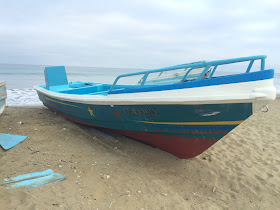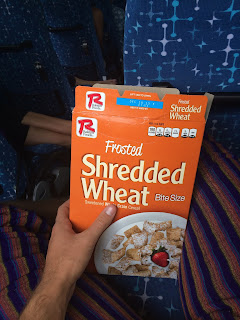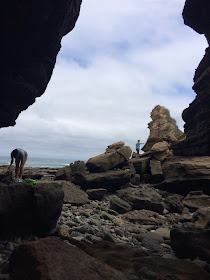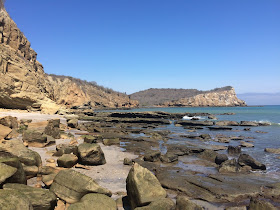I'm back! This past week was spent primarily on a bus as we traveled along the coast from South to North for my Techniques of Marine Research Class. Here's a Google map of the venture, all in all. We had to take a little detour south to avoid going near Cotopaxi:
 |
By far the longest leg was Day 1: Quito to Ayangue (11 hrs). The next was the last: Esmeraldas to Quito (8 hrs). Also I think we did go along the coast between Puerto Lopez and Manta but it doesn't show that on this Google map I just crudely made a minute or two ago
|
Without further ado, here's a breakdown of the trip.
AUG 29/DAY 1:
Left Quito around 8, sat in a bus all day. Drives were gorgeous with a lot of variety including cloud forests and rainforests while we were still in the mountains and then endless agriculture in the lowlands, mostly bananas and corn. Here's a view:
 |
| Through the window, pardon my reflection |
Here's what got me through:
Arrived at night, not sure what time. The scuba shop came and sized us for wetsuits etc. They didn't have booties with them in my size but assured me they'd bring them in the morning of…
AUG 30/DAY 2:


Two humpback whales (mother and calf) were about a football field from us breaching and such. I was still shooting in wide because we had just surfaced so it's hard to see just how close it felt. Others in the group have better pictures because some people were already back on the boat. I was attempting to film and tread water. It was absolutely spectacular. Little did I know that seeing whale breaches would become somewhat commonplace on the trip, although this was the closest encounter. All in all a pretty incredible day, capped off with being able to participate in the family fantasy football draft from my hotel room here.
AUG 31/DAY 3:
This marked our first foray into actual structured science as we hit the road that the unreasonable hour of 6AM to catch to low tide at La Rinconada. It was at this beach that I began the most tedious week of field work you could possibly imagine. There were five or six different projects to work on, and I did not choose wisely when I selected whelk surveying. In theory, searching a beach in each tidal zone for 40 minutes apiece for two species of whelks and then recording their size sounds easy enough. Don't be fooled. It's not so fun when you have to measure upwards of 200 2cm whelks per day. This was basically our entire week: three hours of collecting and sizing whelks on six separate occasions.
 |
| Doing this |
 |
To these
|
The only upside was that we were spewing non-stop whelk puns. Here's a list of the greatest hits:
- A whelk to remember
- I enjoy long whelks on the beach
- You're whelkome
- Whelk me up when september ends
- I whelk the line
- I whelk a lonely road, the only road that I have ever known
- Whelking hard or hardly whelking?
- All in a day's whelk
- and so on…
Afterwards we drove to our next town of Puerto Lopez
SEP 1/DAY 4:
Another field day, this time at La Playita which is part of a national park. It was spectacular:
We then headed to a different beach for a swim and it looked like this:
 |
| Sort of hard to tell here, but the body surfing was fantastic. The water was only slightly cooler than the average bath, just enough to be refreshing. The only downside to this paradise beach was that a couple people got stung by jellyfish, but I didn't and that's really all that matters for my personal assessment |
The town of Puerto Lopez has profited a bunch off of whale tourism, as migrating humpbacks are known to swim right offshore. There are several whale watch companies and dive shops, etc. I also saw breaches from shore here. I think I was on a three day streak of seeing whale breaches. It also had this hostel named after me that we didn't get to stay in:
 |
| I tried to assume the name Flipper as a pre-schooler. Kinda bummed it never really stuck because it's a pretty sweet nickname tbh. Flipper Funnell. Or Flip for short |
SEP 2/DAY 5:
I woke up a little early so I decided to go for a beach walk like any artsy introspective person would do and it led me to the fish market. The number one industry in town is still fishing by far and every morning the entire town (it seems) gathers near the pier as the boats come in. Fishermen set up stands of their catch of the day and sell to families and restaurants because the entire diet of everyone here seems to be seafood. I don't blame them- it's fresh and phenomenal (food blog to come). It looked like this:
 |
 |
| Yeah all the fishing boats look basically identical |
|
 |
| Found this porcupine fish in a boat pulled up on the beach |
 |
View back from the pier. I also saw my first ever sea turtle here, swimming around between the moored boats of the harbor, poking its head up from time to time
Then we hit the road and yet another beach, called la Machalilla. It looked like this:
This was a cool rock
Then we drove some more. Rinse, repeat as they say.
SEP 3/DAY 6:
Another 6AM departure for another 5 hour drive. This time we arrived at a really cool ecolodge called the Playa Escondida Lodge somewhere near Esmeraldas. It's owned by a Canadian woman who said she grew tired of the cold of Vancouver and developed wanderlust about 30 years ago and has been running this place ever since. This was the cottage for four dudes:
Just trying not to get malaria. I think I was successful. I would know by now right?
The beach we surveyed that afternoon was called Playa Escondida. The intertidal life was not nearly as interesting as other beaches (guide to Ecuadorian tidepooling blog coming soon…). But who needs interesting intertidal life when there's ocean life close at hand that looks like this:
We watched it swim around for a bit through the inlets. They're highly protected and you're not allowed to get anywhere near them in the Galápagos but I'm not there yet so I had to touch the shell for curiosity purposes. So cool to be so close to such an awesome animal. I thought for sure this would be my nature highlight of the trip. Then the night came around.
After dinner, a group of us were out on the beach looking at the stars, which were plentiful and clear in this non light-polluted area. Then, under the starlight, a huge sea turtle emerged from the crashing waves and made its way up the beach. Not wanting to disturb or disorient her, we didn't use flashlights or camera flashes as we followed from a distance as she searched for a spot to nest. She settled just outside of the dining area and began to dig with her back flippers. Unfortunately for her, we knew that there was concrete underneath this patch of sand so she wouldn't be able to dig her nest here. She still worked on this spot for about 20 minutes before moving on, leaving this hole:

So we followed her again as she moved back onto the beach and across some distance, before making another right hand turn towards the high shore. This time she again settled up against a concrete wall, but on looser earth. A group of us pulled up chairs and watched her for almost two hours as she dug and dug, taking occasional five minute breaks to rest her exhausted body. After one of these, she started vigorously moving her back flippers and then rocked back and forth on top of the ground, flattening it out with a loud thud on each impact. Satisfied, she paused for a second before making her way back down the beach and once more into the sea. On top of the nest we found one rogue egg:
Deciding that it might attract the attention of dogs (there were a couple at the hotel) or other predators, we removed the egg from the area and headed off to bed a little before midnight, marveling at the near miracle we had all serendipitously witnessed.
SEP 4/DAY 7:
Our last day of field work took us to Estero del Plátano, about 30 minutes down the road. I guess I didn't take any pictures here. It was lovely but it wasn't anything too special so don't worry about missing anything. Here's a bonus video of crabs running to make up for it:
We spent another night under mosquito nets trying not to die but to tell you the truth I hardly saw any mosquitos. I suppose it could've been my 98.11% DEET spray because almost everyone else got at least one bug bite.
SEP 5/DAY 8
Travel day. 8+ more hours in the bus back to Quito. The highlight by far was this hand-sized grasshopper made an appearance on the outside wall of a gas station. This thing could probably dunk on a regulation NBA hoop.
So we made it back home to Cumbayá for the most part unscathed and malaria free around 5PM. A blog post is soon to come about what I've done with my past couple free days, although Facebook probably offers a sneak preview.
|

































































This comment has been removed by the author.
ReplyDelete